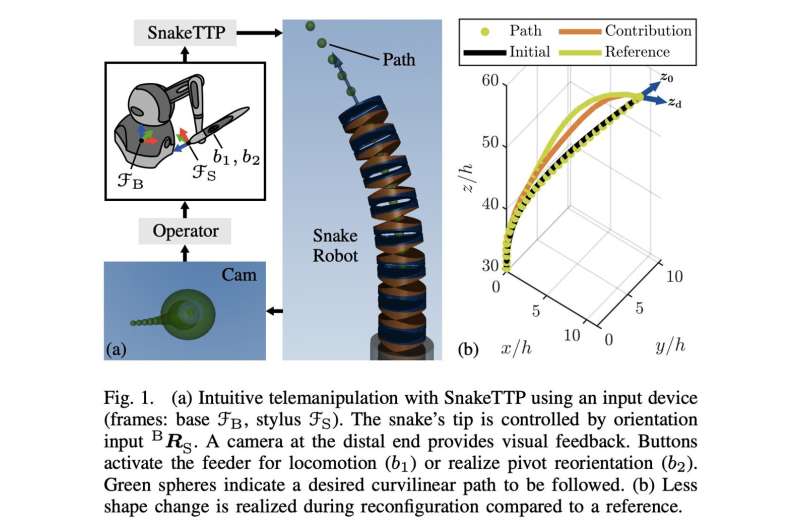March 16, 2023 feature
This article has been reviewed according to Science X's editorial process and policies. Editors have highlighted the following attributes while ensuring the content's credibility:
fact-checked
preprint
trusted source
proofread
An effective strategy to remotely operate snake robots

Animals have always been a great inspiration for robotic systems, as they offer fascinating natural examples of how different body structures can produce specific movements and locomotion styles. While most animal-inspired robots are inspired by legged animal species, some roboticists have been exploring the potential of robots with bodies that resemble those of other animals, including snakes.
Snake-inspired robots have unique characteristics that could make them more suitable than other robots for some technological applications. For instance, their flexible and snake-like motions could make them advantageous for performing minimally invasive surgeries and endoscopic interventions, entering a patient's body through the nose and then reaching target areas.
Despite their advantages, existing methods to operate these robots from afar are not particularly effective. This Is primarily because while snake-like robots are hyper-redundant (i.e., they have a large or infinite number of degrees of freedom), the electronic devices used to control their movements often only allow users to specify six degrees of freedom.
To overcome this limitation, a team of researchers at Leibniz University Hannover recently developed a new strategy for intuitively and remotely manipulating the movements of hyper-redundant snake robots. This strategy, introduced in a paper pre-published on arXiv, allows users to change the movements and orientation of a snake-like robot, while changing its shape as little as possible.
"This paper presents SnakeTTP, a unified algorithm for intuitive telemanipulation realizing locomotion and pivot reorientation for endoscopic tasks," Tim-Lukas Habich and his colleagues wrote in their paper. "The new method based on task-priority inverse kinematics allows different position and orientation specifications at highest priority and shape fitting within the null space. Shape fitting is performed by maximizing the similarity of two curves using Frechet distance while simultaneously specifying the position and orientation of the end effector."
Habich and his colleagues evaluated their SnakeTTP algorithm by asking 14 study participants to control the movements of simulated snake robot and bring it to a target area within a simulated environment. Their results were highly promising, as users controlling the simulated snake robot could successfully complete the locomotion task, and could also re-orient the robot's movements within a target area while changing its shape as little as possible.
"The novel shape-fitting approach based on the Frechet distance reduces the shape error up to 20.1% in contrast to the classical strategy using Euclidean distance between current and desired link positions," Habich and his colleagues wrote in their paper.
While the new control algorithm introduced by this team of researchers achieved promising results, it has so far only been tested on simulated robots. Future tests in real-world environments and using real snake robots could further validate its effectiveness.
Ultimately, the algorithm could allow researchers to control snake robots and other hyper-redundant robots (e.g., robots inspired by octopus tentacles) with greater precision, while also better replicating snake- or tentacle-like movements. This could in turn facilitate the deployment of these robots in medical settings, particularly to perform minimally invasive surgical procedures inside the human body.
More information: Tim-Lukas Habich et al, Intuitive Telemanipulation of Hyper-Redundant Snake Robots within Locomotion and Reorientation using Task-Priority Inverse Kinematics, arXiv (2023). DOI: 10.48550/arxiv.2303.00065
© 2023 Science X Network


















